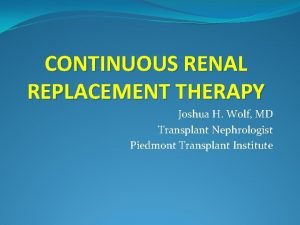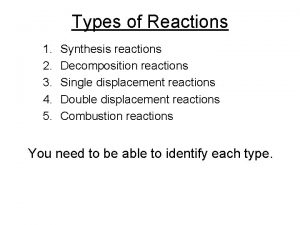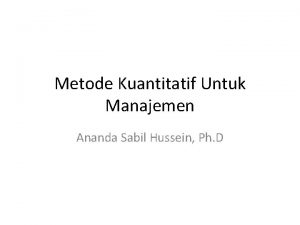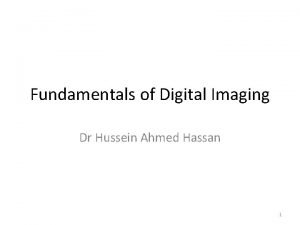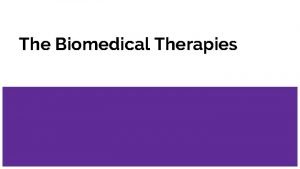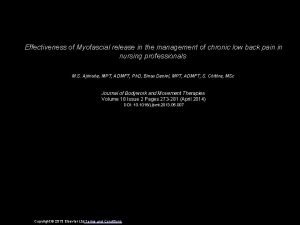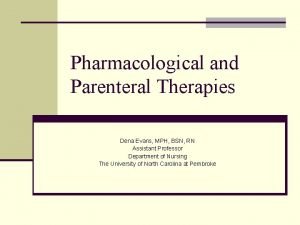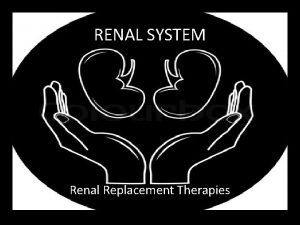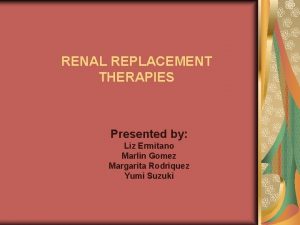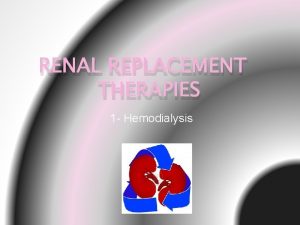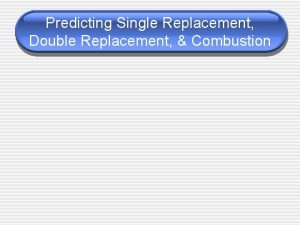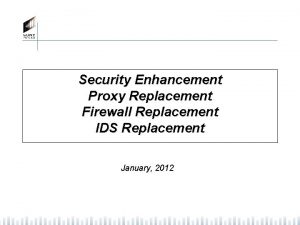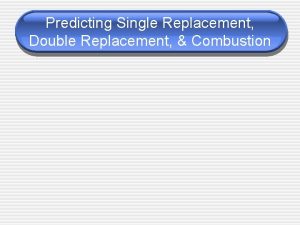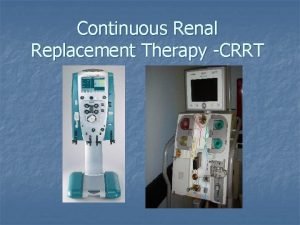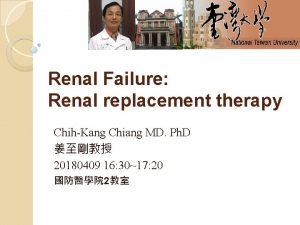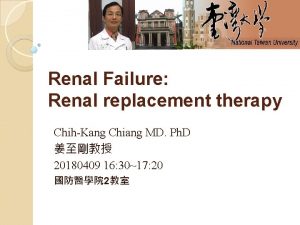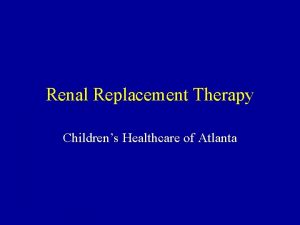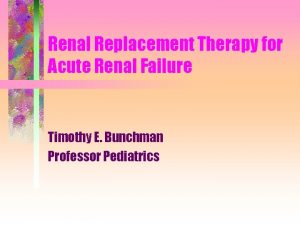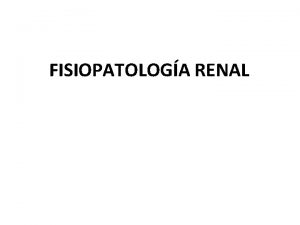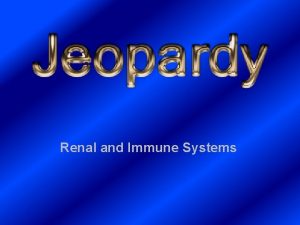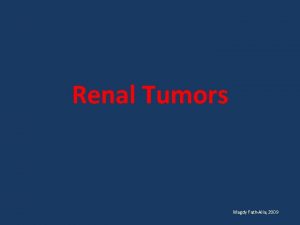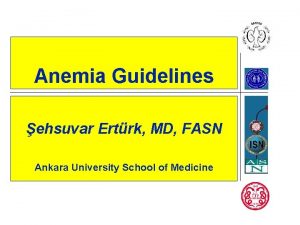Renal Replacement Therapies Hussein H Alhawari MD FASN









































- Slides: 41

Renal Replacement Therapies Hussein H. Alhawari, MD, FASN

Kidney Transplantation… The best!!! Hemodialysis Peritoneal Dialysis

Indications for dialysis? 1. CKD 5 (e. GFR < 15 ml/min) and uremic symptoms. 2. Severe hyperkalemia not responding to medical Rx. 3. Severe metabolic acidosis NRTM Rx. 4. Severe fluid overload NRTM Rx. 5. Uremic encephalopathy. 6. Uremic pericarditis. 7. Drug overdose.

Hemodialysis is an extracorporeal therapy that is prescribed to reduce the signs and symptoms of uremia and to replace partially a number of the key functions of the kidneys when kidney function is no longer sufficient to maintain the patient’s well-being or life.


Hemodialysis used in the treatment of ESRD is effective in: (a) Reducing the concentration of uremic toxins. (b) Reducing excess fluid volume by ultrafiltration. Remember most dialysis patients do not urinate!!! (c) Correcting some of the metabolic abnormalities, such as acidosis and hyperkalemia.



Vascular access AV fistula is the best access! AVG is second. Hemodialysis catheters… Only if you have to!

AVF

AVG

Hemodialysis catheter

HD patient with fever in the ER…. First question to ask? Dialysis access? If HD catheter… IT IS HD CATHETER INFECTION TILL PROVEN OTHERWISE. Most of the times they will require admission and empiric broad spectrum antibiotics.

Peritoneal Dialysis With peritoneal dialysis, the peritoneal membrane is used as the dialyzing surface. Peritoneal dialysis primarily represents solute and fluid exchange across the peritoneal membrane between the peritoneal capillary blood and the dialysis solution that is instilled into the peritoneal cavity.


Types of Peritoneal Dialysis Continuous ambulatory peritoneal dialysis (CAPD) involves multiple exchanges during the day followed by an overnight dwell. Automated peritoneal dialysis (APD) refers to techniques that use an automated device to do multiple exchanges overnight, such as continuous cycler peritoneal dialysis (CCPD).

Peritoneal Dialysis Solutions Peritoneal dialysis solutions primarily consist of water, osmotic agents, electrolytes, and minerals.

Osmotic agents allow net water removal by altering the osmotic pressure gradient between the peritoneal dialysis solution and plasma water. Dextrose is the most commonly used osmotic agent. Available dextrose concentrations include 1. 5, 2. 5, and 4. 25 percent solutions.



Icodextrin-containing solutions can cause falsely elevated glucose levels. In patients using icodextrin, blood glucose monitoring must be done with glucose-specific methods to prevent falsely elevated levels and subsequent inappropriate treatment of presumed hyperglycemia.

Complications of PD Peritonitis PD catheter exit site infection and tunnel infection. Catheter malfunction. Hernias. Fluid leaks. Peritoneal membrane changes… Encapsulating peritoneal sclerosis and UF failure.

Peritonitis remains a major complication of PD despite advances in equipment and aseptic technique. Peritonitis accounts for 15% to 35% of hospital admissions for these patients and is the major cause of catheter loss and technique failure resulting in transfer to hemodialysis.

Entry of bacteria into the catheter during an exchange procedure (touch contamination) is the most common source, but organisms can also track along the external surface of the catheter or migrate into the peritoneum from another abdominal viscus.

Diagnosis of peritonitis requires the presence of two of the following criteria in any combination: 1. Organisms identified on Gram staining or subsequent culture 2. Cloudy fluid (white cell count >100/mm 3; >50% neutrophils) 3. Symptoms and signs of peritoneal inflammation.

Cloudy dialysate effluent is almost invariably present, and abdominal pain is present in about 80% to 95% of cases. Gastrointestinal symptoms, chills, and fever are present in as many as 25% of the cases, and abdominal tenderness in 75%.

Historically, coagulase-negative staphylococci were the most common cause of peritonitis in continuous ambulatory peritoneal dialysis (CAPD), presumably due to touch contamination or infection via the pericatheter route. The use of Y systems (or flush before fill) has reduced the incidence of coagulasenegative staphylococcal peritonitis, with a relative increase in the incidence of peritonitis due to Staphylococcus aureus.

Initial empiric antibiotic coverage for peritoneal dialysis-associated peritonitis consists of coverage for gram-positive organisms (by vancomycin or a first-generation cephalosporin) and gram-negative organisms (by a thirdgeneration cephalosporin or an aminoglycoside). Subsequently, the regimen should be adjusted based on culture and sensitivity data.

Indications for catheter removal include relapsing or refractory peritonitis, refractory catheter infection, fungal or mycobacterial peritonitis, and peritonitis associated with intraabdominal pathology. Peritonitis due to multiple enteric organisms or mixed gram-negative/gram-positive organisms should raise concern for a concurrent intraabdominal condition such as ischemic bowel or diverticular disease.

Most episodes of peritoneal dialysis-associated peritonitis resolve with outpatient antibiotic treatment; overall cure rates are approximately 75 percent.

DM patients on PD Most DM patients will require insulin while they are on PD, even if they did not require it before PD. This partly the result of glucose absorption from the dialysate and associated weight gain. Insulin can be given via IP route or SC.

Kidney Transplantation Kidney transplantation is the treatment of choice for most patients with end-stage renal disease (ESRD) because it prolongs survival, improves quality of life, and is less costly than the alternative therapy of dialysis. However, only a small percentage of ESRD patients actually receive a transplant; many patients are not suitable candidates, and for those patients who are eligible, there are simply not enough organs available.

Absolute contraindications to renal transplantation include: Active infections. Active malignancy. Active substance abuse. Reversible renal failure. Uncontrolled psychiatric disease. Documented active and ongoing treatment nonadherence. A significantly shortened life expectancy.

Timing of Referral In the United States, the United Network for Organ Sharing (UNOS) allows listing for transplantation when a patient’s estimated glomerular filtration rate (e. GFR) falls below 20 m. L/min, whereas organizations in other countries have established stage 5 CKD (e. GFR below 15 m. L/min) as the upper limit for listing.

In Jordan… Only Living Related Donors. ABO and Tissue matching…

60 yo lady with DM > 20 years, HTN > 20 years, progressive diabetic nephropathy with serum Cr as of today’s clinic visit of 4. 8 (e. GFR around 9 ml/min). Na 138. K 4. 9. HCO 3 22. She still has good urine output. She denies any uremic symptoms and feels very good. She has left arm AVF placed 6 months ago and looks very good. What is your best next step? A. Admit to the hospital and start dialysis soon. B. Since she has a good left arm AVF just call outpatient HD unit and start HD as outpatient. C. Continue close outpatient follow up (monthly visit with monthly lab). D. RTC every 3 months with routine lab. E. Refer her for kidney biopsy.

62 yo man with DM > 15 years, HTN > 15 years, progressive CKD secondary to DM + HTN presented for regular follow up visit. Cr is 5. 2 (e. GFR 7 ml/min). K is 5. 2. HCO 3 18. He complains of metallic taste, weakness and weight loss. He has left arm AVF in placed 4 months ago and looks very good. What is the best next step? A. Refer to the ER. B. Arrange to start HD ASAP. C. No urgent indications to start HD so continue monthly follow up visit. D. Refer for kidney biopsy and eye exam. E. RTC every 3 months with routine lab.

35 yo man with ESRD on PD presented to the ER c/o RLQ abdominal pain and nausea for 2 days. PD fluid is clear. PD fluid cell count showed 30 WBCs. What is the best next step? A. Admit for IV antibiotics for presumed peritonitis. B. D/C home on IP antibiotics after arranging with PD nurse. C. D/C home on oral antibioitcs. D. D/C home on NSAIDs E. Rule out other etiologies for his presentation.

70 yo man presented to the ER c/o fever, chills and SOB for one week. CXR showed bilateral pneumonia. BP is 100/60 (baseline around 140 s-150 s/80 s-90 s). Lab showed Cr of 5. 0. K 7. 0. EKG showed hyper-acute T waves. What is the best next step? A. IV calcium gluconate. B. PO kayexalate. C. IV furosemide D. Arrange for HD catheter placement then dialysis. E. IV antibiotics.

65 yo with ESRD on HD, DM > 20 years, HTN > 20 years. He was found dead this morning in his bed. Last HD was 2 days ago. What is the most likely cause of his death? A. Hyperkalemia. B. Pulmonary edema. C. Acute MI. D. DKA. E. Uremic pericarditis.

Questions? ?
 Ira pré renal renal e pós renal
Ira pré renal renal e pós renal Sindrome nefrótica
Sindrome nefrótica Psychodynamic vs psychoanalytic
Psychodynamic vs psychoanalytic Vasa recta vs peritubular capillaries
Vasa recta vs peritubular capillaries Rrt aeiou
Rrt aeiou Example of combustion reaction
Example of combustion reaction Wal hamdu lillahi rabbil 'alamin
Wal hamdu lillahi rabbil 'alamin Hussein suleman
Hussein suleman Ananda sabil hussein
Ananda sabil hussein Mbbsch
Mbbsch Laila hussein
Laila hussein George h. w. bush apush
George h. w. bush apush Mbbsch
Mbbsch Audrey sedal
Audrey sedal Hussein suleman
Hussein suleman Karen hussein
Karen hussein Saddam hussein
Saddam hussein Hussein suleman
Hussein suleman Anichya gujral
Anichya gujral Nadya hussein
Nadya hussein Saddam hussein
Saddam hussein Diyar hussein
Diyar hussein Hussein suleman
Hussein suleman Hussein bey
Hussein bey How to kill a chicken
How to kill a chicken Bassam hussein
Bassam hussein Hussein suleman
Hussein suleman Dr hussein saad
Dr hussein saad Hussein mahmood 1985
Hussein mahmood 1985 Dr. hussein shaqra
Dr. hussein shaqra Taha hussein challenges
Taha hussein challenges Principles of phc
Principles of phc Advantages of group therapy
Advantages of group therapy Acceleration behavioral therapies
Acceleration behavioral therapies What is a biomedical treatment
What is a biomedical treatment Most common form of biomedical therapy
Most common form of biomedical therapy Bodywork and movement therapies
Bodywork and movement therapies Advanced therapies apprenticeship community
Advanced therapies apprenticeship community Pharmacological and parenteral therapies
Pharmacological and parenteral therapies Iapt trafford
Iapt trafford Stiriti ayur therapies private limited
Stiriti ayur therapies private limited Insight therapies involve verbal interactions
Insight therapies involve verbal interactions




